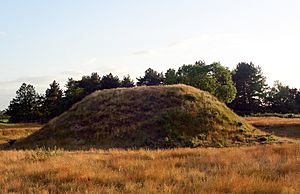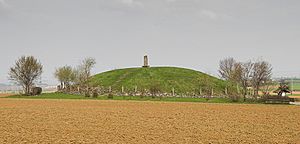Anglo-Saxon burial mounds facts for kids
An Anglo-Saxon burial mound is a large pile of earth and stones built over a grave or burial chamber. These mounds were created in Anglo-Saxon England during the late 500s and 600s AD. They are also known as barrows or tumuli.
Early Anglo-Saxon burials often involved placing bodies or ashes in cemeteries. At first, the Anglo-Saxons followed a pagan religion. But as Christianity arrived in the 600s, it slowly became the main religion. Many people buried in these mounds were pagan, but some were Christian. It's often hard for archaeologists to know which religion a person followed.
Even older groups in Britain, during the Stone Age and Bronze Age, also built barrows for burials. The Anglo-Saxons knew about these older mounds. In many cases, they even re-used these ancient sites for their own burials.
Contents
A Look Back: Burial Mounds Through History
Building burial mounds wasn't just an Anglo-Saxon idea. It was a very old practice in Europe, going back thousands of years. By the time of the Anglo-Saxons, many different groups built them. This included Germanic-speaking, Slavic-speaking, and Celtic-speaking peoples. They often used these mounds for important leaders or wealthy members of their societies.
During the Roman Iron Age, mound building stopped in Britain. But it continued in parts of Europe not ruled by the Romans. For example, the Hallstatt culture in central Europe (around 750 to 400 BCE) buried their elite in chambers inside mounds. A famous example is the Hochdorf Chieftain's Grave from about 550 BCE. It was filled with many valuable items.
By the 500s CE, when Anglo-Saxons started building mounds, other Germanic groups in Europe were doing it too. In Thuringia, Germany, archaeologists have found important chamber burial mounds. One cemetery in Trossingen, from about 580 CE, is from the same time as similar Anglo-Saxon sites.
How Anglo-Saxons Started Building Mounds
The Anglo-Saxon peoples moved to Britain in the 400s CE. They settled mostly in the eastern parts of what is now England. They followed a pagan religion. The practice of building barrow burials was adopted by the Merovingian dynasty Franks. The Franks lived in what is now France and started building mounds in the mid-400s CE. It's likely the Anglo-Saxons learned this practice from these Merovingian Franks.
Throughout the 500s, the south-eastern Anglo-Saxon Kingdom of Kent became politically close to the Merovingian kings in Francia. Their royal families even formed an alliance through marriage. Because of this connection, the Kentish Anglo-Saxons began burying their important people in large mounds, just like the Merovingians. The Kingdom of Kent was very important in southern England. Its influence then led Anglo-Saxon groups north of the Thames to also start building these mounds.
Building a Burial Mound: Step-by-Step
Building a burial mound was a much longer process than a normal Anglo-Saxon burial. The funeral rites and preparations could last for at least a week.
- Step 1: Preparing the Ground
First, a circular area of topsoil was removed. Then, a ditch was dug around this circle, making it even deeper. Archaeologist Martin Carver thought this first step was symbolic. It created a special inner zone for the burial, separate from the outside world.
- Step 2: Digging the Grave
Next, a grave was dug into the ground. It needed to be big enough for a body. Some of the most important mounds had special burial chambers. These were richly decorated wooden rooms buried inside the mound. In other cases, the body was simply placed in the ground, and a pile of stones and earth was raised on top.
- Step 3: Placing the Body
For some burials, a step or platform was cut into one end of the grave. This allowed mourners to kneel down and arrange the body and its grave goods. Sometimes, the bottom of the grave was sealed with clay before the body and its items were placed inside.
- Step 4: The Funeral Service
Once the body was in the grave, a funeral service would take place. This included special rituals and often a meal eaten at the graveside. A covering was then placed over the body. This was usually cloth, but sometimes it was made of hazel poles or stakes. For chamber burials, the wooden roof of the chamber would be sealed at this point.
- Step 5: Building the Mound
With the grave complete, the final step was to build the earthen mound on top. Some of the earth came from the ring ditch around the barrow. Other soil was brought from the surrounding area. It's possible that a wooden post was placed at the very top of the mound once it was finished, marking the burial site.
Why Were Mounds Built?
Archaeologists and historians have thought a lot about why the Anglo-Saxons built these mounds.
- Claiming Land: Anglo-Saxon expert Stephen Pollington noted that mounds were a way to create "a permanent mark on the landscape." They allowed people to "claim the territory and the right to hold it." It was like saying, "This land belongs to us."
- Home for the Dead: Pollington also said that "the burial chamber was an idealised portrayal of the 'house of the dead'." It was seen as the final resting place for the person who had died. It was a place where they might welcome those who visited them through spiritual journeys.
- Symbol of Life: Another idea, from Weston Wyly, is that the mounds were like the pregnant belly of the earth. The body, representing a human seed, was planted inside. This could symbolize new life or a connection to the earth.



